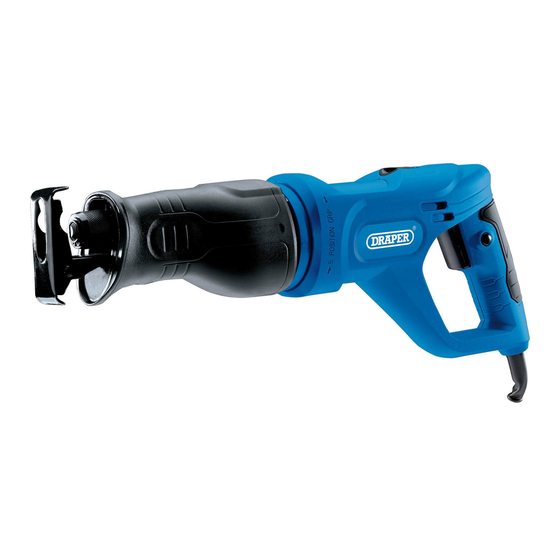Draper 83628 사용 설명서 - 페이지 11
{카테고리_이름} Draper 83628에 대한 사용 설명서을 온라인으로 검색하거나 PDF를 다운로드하세요. Draper 83628 20 페이지. 710w 230v reciprocating saw
Draper 83628에 대해서도 마찬가지입니다: 사용자 설명서 (20 페이지)

9.
BASIC RECIPROCATING SAW OPERATION
9.1 SWITCH AND VARIABLE STROKE
RATE CONTROL - FIG. 5
Your reciprocating saw is equipped with a trigger
switch to turn the saw on and off, and to control
the speed.
-
To start the saw, press the trigger switch
-
To stop the saw, release the trigger switch.
-
To vary the stroke rate, simply increase or
decrease the pressure on the trigger switch.
The tighter the trigger switch is pressed, the
higher the speed.
-
When sawing for any extended period of time
it is possible to lock-on this saw. With the trigger
release
. The saw will continue to run. To stop the saw squeeze the trigger
and release. Note: Always ensure saw trigger
accidental starting.
9.2 GENERAL CUTTING
WARNING: Before plugging in the tool, always check to see that the switch is actuated
properly and returns to the off position when released.
WARNING: Hold the tool only by the rear handle and the insulated grip area, which helps
prevent electrical shock. When sawing into walls or floors you may encounter electrical
wiring. Sawing into a "live" wire will cause electric shock.
-
Make sure the workpiece is firmly anchored. Clamp the workpiece to prevent slipping or
moving while cutting.
-
Use the appropriate type and size of blade for the workpiece material and size.
-
Check for clearance beyond the workpiece so the blade will not impact another surface.
-
Mark the line of cut clearly. If cutting metal, apply cutting oil on the line.
-
Depress the trigger switch to start the saw and bring it to maximum desired cutting
stroke rate before applying the blade to the workpiece.
-
Do not force the tool. Place the shoe firmly on the workpiece while cutting. Use only
enough steady pressure on the blade to keep the saw cutting. Reduce pressure as the
blade comes to the end of the cut.
-
Cutting stroke rates should vary with the workpiece. Hard materials such as metals
require lower stroke rates, for softer materials use higher stroke rates.
-
Check wood, chip boards, building materials etc. for foreign objects (nails, screws, etc.)
before sawing and remove them, if necessary.
-
Position the pivoting footplate
work applying uniform contact pressure of feed.
If the saw blade jams, switch off the tool immediately. Widen the gap somewhat with a
suitable tool and pull out the saw blade.
FIG.5
.
pressed, push in the button
is off/released after each use to prevent
onto the surface of the work and saw through the
and
again
11
